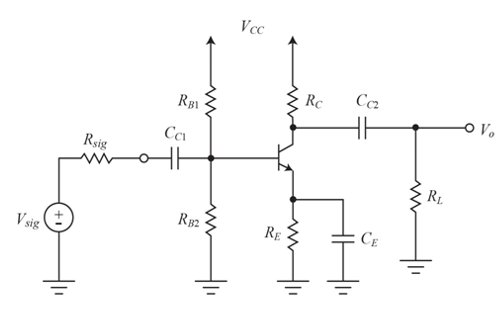
The
Given Information:

Fig: Given circuit
Calculation:
Write the equation for trans-conductance
Where
Plugging the values
The expression for frequency
Plugging the values
Write an equation for the effective load resistance of the amplifier
Plugging given values.
The expression for total input capacitance is given by,
Plugging given values.
Write an equation for the equivalent base resistance of the amplifier
Plugging given values.
Write the equation for resistance
Plugging the values
Write an equation for the effective signal resistance of the amplifier
Plugging given values.
Write the equation for 3-dB frequency as follows:
Plugging given values.
Write the equation for the corresponding gain
Plugging given values.
Want to see the full answer?
Check out a sample textbook solution
Chapter 10 Solutions
MICROELECTRONIC CIRCUITS W/LAB MAN >P<
- Don't use ai to answer I will report you answerarrow_forwardanA fluid level control system includes a tank, a level sensor , a fluid source and an actuator to control fluid inflow. Show how the fluid level could be digitally controlled using a block diagramarrow_forwardsee the following imagearrow_forward
- Calculate A, B, C, and D constants, sending end voltage and sending end current of a 3-phase, 50-Hz overhead transmission line 100 km long has the following constants Resistance/km/phase = 0.1, Inductive reactance/km/phase 0.20, Capacitive susceptance/km/phase = 0.04 x 10 siemen. when supplying a balanced load of 10,000 kW at 66 kV, p.f. 0-8 lagging. Use nominal T method. andarrow_forwardDon't use ai to answer I will report you answerarrow_forwardNO AI PLEASE WILL REJECTarrow_forward
- NO AI PLEASE WILL REJECTarrow_forwardDon't use ai to answer I will report you answer. Please give explanation for both correct options and incorrectarrow_forward14:00 APP Voi) 5G 鼷浴醵郯興47% atheva.cc/index/index/index.html The Most Trusted, Secure, Fast, Reliable Cryptocurrency Exchange Get started with the easiest and most secure platform to buy, sell, trade, and earn Cryptocurrency Balance:1000.00 Recharge Withdraw Message About us BTC/USDT ETH/USDT EOS/USDT 83259.00 1841.46 83259.00 +1.02% +0.08% +1.02% Operating norms Symbol B BTC/USDT Latest price 24hFluctuation 83259.00 +1.02% ETH/USDT 1841.46 +0.08% B BTC/USD illı 83259.00 +1.02% Home Markets Trade Record Mine О <arrow_forward
 Introductory Circuit Analysis (13th Edition)Electrical EngineeringISBN:9780133923605Author:Robert L. BoylestadPublisher:PEARSON
Introductory Circuit Analysis (13th Edition)Electrical EngineeringISBN:9780133923605Author:Robert L. BoylestadPublisher:PEARSON Delmar's Standard Textbook Of ElectricityElectrical EngineeringISBN:9781337900348Author:Stephen L. HermanPublisher:Cengage Learning
Delmar's Standard Textbook Of ElectricityElectrical EngineeringISBN:9781337900348Author:Stephen L. HermanPublisher:Cengage Learning Programmable Logic ControllersElectrical EngineeringISBN:9780073373843Author:Frank D. PetruzellaPublisher:McGraw-Hill Education
Programmable Logic ControllersElectrical EngineeringISBN:9780073373843Author:Frank D. PetruzellaPublisher:McGraw-Hill Education Fundamentals of Electric CircuitsElectrical EngineeringISBN:9780078028229Author:Charles K Alexander, Matthew SadikuPublisher:McGraw-Hill Education
Fundamentals of Electric CircuitsElectrical EngineeringISBN:9780078028229Author:Charles K Alexander, Matthew SadikuPublisher:McGraw-Hill Education Electric Circuits. (11th Edition)Electrical EngineeringISBN:9780134746968Author:James W. Nilsson, Susan RiedelPublisher:PEARSON
Electric Circuits. (11th Edition)Electrical EngineeringISBN:9780134746968Author:James W. Nilsson, Susan RiedelPublisher:PEARSON Engineering ElectromagneticsElectrical EngineeringISBN:9780078028151Author:Hayt, William H. (william Hart), Jr, BUCK, John A.Publisher:Mcgraw-hill Education,
Engineering ElectromagneticsElectrical EngineeringISBN:9780078028151Author:Hayt, William H. (william Hart), Jr, BUCK, John A.Publisher:Mcgraw-hill Education,





